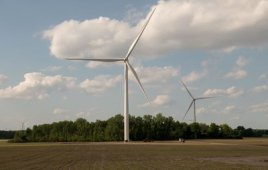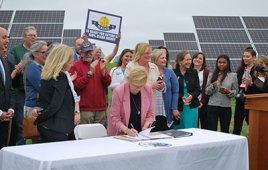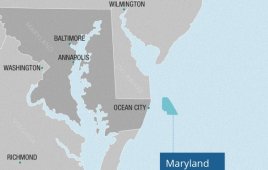A first step in the development of a wind farm is to identify land with sufficient wind to support a commercial project. This calls for a series of studies, one of which is the wind-study assessment that looks at historical wind data. There may be a meteorological or met tower in the area that has accumulated sufficient information. Study teams might also look at weather archives and model-out on that data to find what a potential wind farm could produce.
A wind assessment along with transmission and environmental studies, can also tell if it is feasible to put together several land owners to commercially produce power. Landowners can try to put together a wind project on their own but it’s a complex process that often benefits greatly from the expertise of a community developer. There are several business structures that guide development of community wind.
Site assessments are actually not required by law, but certainly before permitting a wind farm, authorities ask for a lot detail about the wind regime that an assessment provides. Also, banks providing the financing will require not just one assessment, but more likely two or three. Different firms use different techniques. With such a big price tag on theses projects, its common sense to get several assessments. If all two or three are within reason, the banks feel better.
The assessment comes in different phases. The first is more prospecting. It answers the questions: What is the potential of this area? What are the prospective wind speeds in the area, and what do state resource maps say about the wind in a certain local?
While the meteorological tower is collecting data, for example, other companies are planning tasks such as pinpointing the best wind resources in an area, looking for residences, roads, and set backs needed for historical sites, and microwave beams paths.
A site assessment ranges from $15,000 to $30,000 not including met towers. Those might add another $15,000 each. Software used in the assessment also helps establish a setback from homes for the wind farm. This is to make sure residents endure only minimal noise and shadow flicker. Such an event occurs on sunny days when the rotor’s shadow passes over a building. Flashing or flickering bothers some people. Simulation software now predicts the effect and helps avoid it. Software also calculates the cumulative flickering during the year. There is no universal standard for the number of hours a person might tolerate, but a German standard has set a period of not more then 30 hours per year as a maximum exposure. This is a commonly accepted standard and all assessment groups try to mitigate shadow flicker exposure as much as possible.
Two additional studies (ecological and historical) are done by biologists and anthropologists that will walk the proposed site. Biologists look for evidence of wild life that might be harmed by construction activities while archeologists might dig a few holes and look for evidence of previous habitation and burial sites. In most cases, when sensitive archeological evidence turns up and its location coincides with a proposed turbine foundation or road, planners simply move the structure’s location 50 m one way or another.
Large facilities draw a lot of power from a grid so grid owners want to know how much and when they will need the power. A similar question is asked on the opposite side of the coin when a wind farm wants to inject power into the grid. Its owners want to know: How much and when? Of all things encountered in the world of power generation, regardless of source, permission to inject power is hardest to get, at least in the Midwest. If you want to inject 100 MW might require waiting three to seven years for transmission and demand to catch up with the growing supply.
.
Filed Under: Uncategorized




